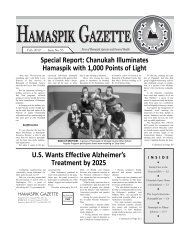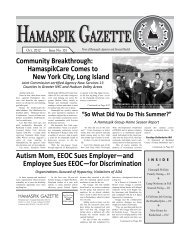About Down Syndrome - Hamaspik.org
About Down Syndrome - Hamaspik.org
About Down Syndrome - Hamaspik.org
Create successful ePaper yourself
Turn your PDF publications into a flip-book with our unique Google optimized e-Paper software.
2<br />
In the Know<br />
All about… <strong>Down</strong> syndrome<br />
Fear of the unknown, and the<br />
misunderstandings and offenses it<br />
can engender, is perhaps nowhere<br />
more seen than in uninformed reactions<br />
to individuals with <strong>Down</strong> syndrome.<br />
That’s because <strong>Down</strong> syndrome<br />
is the world’s most common genetic<br />
medical disorder. Chances are<br />
you’ve seen its unmistakable signs<br />
on the faces of numerous children or<br />
young adults.<br />
It also can lead to mistakes—<br />
errors in thought, speech or action,<br />
many committed with the finest of<br />
intentions. But with a little knowledge,<br />
sensitivity and compassion,<br />
<strong>Down</strong> syndrome, like any other disability,<br />
can easily be demystified.<br />
What is <strong>Down</strong> syndrome?<br />
<strong>Down</strong> syndrome is named after<br />
Dr. John Langdon <strong>Down</strong>, the British<br />
physician who studied it in the<br />
1860s.<br />
People with <strong>Down</strong> syndrome<br />
have a distinct facial appearance.<br />
Though not all people with <strong>Down</strong><br />
syndrome have the same features,<br />
some of the more common ones are<br />
flattened nose, protruding tongue,<br />
small head and/or chin, upwardslanting<br />
eyes, and unusually shaped<br />
ears or short neck.<br />
People with <strong>Down</strong> syndrome<br />
may also have hearing deficits, poor<br />
muscle tone, short hands with a single<br />
crease in the palm, relatively<br />
short fingers, excessive flexibility,<br />
and a larger-than-normal space<br />
between the first and second toes.<br />
Infants born with <strong>Down</strong> syndrome<br />
may be of average size, but<br />
typically they grow slower and<br />
remain shorter than other children of<br />
similar age. Children with <strong>Down</strong><br />
syndrome also have some degree of<br />
mental retardation, from very mild<br />
(IQ 50-70) and moderate (IQ 35-50)<br />
to severe. Most people with <strong>Down</strong><br />
syndrome have MR in the mild to<br />
moderate range.<br />
Health concerns for individuals<br />
with <strong>Down</strong> syndrome include congenital<br />
heart defects, gastroesophageal<br />
reflux disease, recurrent<br />
ear infections, obstructive sleep<br />
apnea, and thyroid dysfunctions.<br />
On the other hand, people with<br />
<strong>Down</strong> syndrome enjoy several as-ofyet<br />
unexplained health benefits,<br />
including lower risk of hardening of<br />
the arteries and diabetic retinopathy,<br />
and greatly reduced occurrences of<br />
many common cancers except<br />
leukemia and testicular cancer.<br />
Due to Dr. <strong>Down</strong>’s perception<br />
that children with the syndrome<br />
shared facial similarities with the<br />
“Mongolian race,” <strong>Down</strong> used the<br />
term Mongoloid to describe them.<br />
<strong>Down</strong> syndrome individuals were<br />
thus described as “having<br />
Mongoloid features” or being<br />
“Mongoloid” until about a generation<br />
ago; that phrase has been largely<br />
discarded.<br />
A century ago, <strong>Down</strong> syndrome<br />
children barely lived past age ten.<br />
Today, thanks to vast tectonic shifts<br />
in societal thinking and major medical<br />
breakthroughs, individuals with<br />
<strong>Down</strong> syndrome can live relatively<br />
happy, healthy, productive and mainstreamed<br />
lives through their 40s and<br />
50s and even beyond.<br />
Causes and types<br />
of <strong>Down</strong> syndrome<br />
In 1959, researcher Jerome<br />
Lejeune discovered that <strong>Down</strong><br />
patients had three, not the normal<br />
two, copies of Chromosome 21.<br />
<strong>Down</strong> syndrome was thus found to<br />
be genetic in cause.<br />
To preface, the human body contains<br />
billions of cells: skin cells,<br />
bone cells, muscle cells and so on.<br />
Each cell contains 46 chromosomes—two<br />
identical sets of 23<br />
each, one from each parent.<br />
The chromosomes tell each cell,<br />
and each body part, exactly how to<br />
grow. Most physical characteristics,<br />
and physical defects, are dictated by<br />
precise chromosomal configurations.<br />
Normally, babies carry two sets<br />
of 23 chromosomes in each cell.<br />
<strong>Down</strong> syndrome babies, however,<br />
carry one extra Chromosome 21 in<br />
one of those sets. The child thus has<br />
a condition medically called Trisomy<br />
21, or three #21 chromosomes, not<br />
two. This creates a total of 47 chromosomes,<br />
not the normal 46.<br />
Approximately 95% of <strong>Down</strong><br />
syndrome cases are the full Trisomy<br />
21 incidences. (More on the other<br />
5% below.)<br />
The body’s cells multiply by<br />
dividing—meaning, say, for a bone<br />
to grow, a single bone cell will split<br />
into two, then four, then eight, and<br />
so on. The extra Chromosome 21 is<br />
created when cells do not correctly<br />
divide at various points of the fetus’<br />
very early development. When a<br />
complete third copy of Chromosome<br />
21 is created, either from the father<br />
or mother, Trisomy 21 results.<br />
In 1-2% of <strong>Down</strong> syndrome<br />
cases, some cells first contain the<br />
extra chromosome but then somehow<br />
do not. Alternatively, only<br />
some, not all, of the body’s cells<br />
contain the extra chromosome.<br />
These two variants are called Mosaic<br />
<strong>Down</strong> syndrome.<br />
The remaining 2-3% of <strong>Down</strong><br />
syndrome occurs when extra pieces<br />
of Chromosome 21 are created—but<br />
become physically translocated, or<br />
attached to another chromosome,<br />
usually Chromosome 14. These are<br />
known variously as Translocation,<br />
Robertsonian or Familial <strong>Down</strong> syndrome.<br />
In extremely rare cases, if the<br />
extra copy of Chromosome 21 is<br />
missing a few pieces—or consists of<br />
only a few pieces—it creates<br />
“Partial-copy” <strong>Down</strong> syndrome, in<br />
which the physical and/or mental<br />
characteristics of <strong>Down</strong> syndrome<br />
may not even be present.<br />
The medical effects of the extra<br />
copy (or pieces of copy) vary greatly,<br />
depending on the extent of the<br />
extra copy and genetic history.<br />
Risks of <strong>Down</strong> syndrome<br />
Currently, there’s no way to prevent<br />
<strong>Down</strong> syndrome.<br />
There are no known behavioral<br />
or environmental factors that cause<br />
<strong>Down</strong> syndrome. It occurs in people<br />
of all races and economic levels.<br />
In 2006, the U.S. Centers for<br />
Disease Control and Prevention<br />
(CDC) estimated the <strong>Down</strong> syndrome<br />
rate as one per 733 live births<br />
in the United States (5,429 new<br />
cases per year).<br />
<strong>Down</strong> syndrome births are statistically<br />
much more common<br />
among older mothers, because incorrect<br />
cell division is more common<br />
among older mothers. For example,<br />
at age 20 to 24, the probability is<br />
about one in 1,500, while a 35-yearold<br />
has about a one in 350 chance,<br />
which increases gradually to about<br />
one in 100 by age 40. At age 45, the<br />
incidence becomes approximately<br />
one in 33 and above age 45, the<br />
probability is about one in 19.<br />
Although the probability<br />
increases with maternal age, 80% of<br />
children with <strong>Down</strong> syndrome are<br />
born to mothers under 35, simply<br />
because younger mothers have more<br />
babies. Recent data suggest that<br />
paternal age, especially beyond 42,<br />
also increases <strong>Down</strong> syndrome risk.<br />
Other factors may also play a<br />
role: A mother with one <strong>Down</strong> syndrome<br />
child has about a one in 100<br />
chance of having another, and being<br />
a carrier of the genetic translocation<br />
for <strong>Down</strong> syndrome can result in the<br />
translocation being passed on to<br />
children.<br />
In these translocation cases, the<br />
mother or father is a balanced carrier<br />
of the translocation, which means<br />
he or she has some rearranged chromosomes,<br />
but no extra pieces of<br />
chromosomes. A balanced carrier<br />
has no signs or symptoms of <strong>Down</strong><br />
syndrome, but he or she can pass the<br />
translocation on to children.<br />
As a matter of a fact, translocation<br />
<strong>Down</strong><br />
syndrome<br />
is<br />
the only<br />
form of the<br />
disorder that<br />
can be passed<br />
from parent to<br />
child. However,<br />
only about 2-3% of<br />
children with <strong>Down</strong><br />
syndrome have that<br />
type. And only about half<br />
of these cases are inherited<br />
from one of the parents.<br />
The chance of passing on the<br />
translocation depends on the gender<br />
of the parent who carries it: If the<br />
father is the carrier, the risk is about<br />
3 percent; if the mother is the carrier,<br />
the risk is about 12 percent.<br />
Diagnosing<br />
<strong>Down</strong> syndrome<br />
If <strong>Down</strong> syndrome is not diagnosed<br />
before birth, a newborn’s<br />
physical features often clearly tell<br />
doctors whether the child has <strong>Down</strong><br />
syndrome. But these traits can be<br />
subtle in a newborn.<br />
Doctors can often make a diagnosis<br />
by doing a physical exam. But<br />
to be absolutely certain, doctors will<br />
order a blood sample taken for a<br />
chromosomal karyotype, an analysis<br />
of the child’s chromosomes.<br />
It may take two to three weeks<br />
to get the complete results of this<br />
test. If there’s an extra Chromosome<br />
21 present in all or some of the cells,<br />
the diagnosis is <strong>Down</strong> syndrome.<br />
Becoming a <strong>Down</strong><br />
syndrome parent<br />
When parents learn that their<br />
child has <strong>Down</strong> syndrome, they may<br />
experience a wide range of emotions,<br />
including anger, fear, worry,<br />
E6<br />
June ‘10 | <strong>Hamaspik</strong> Gazette
sorrow, self-pity and guilt. They<br />
may not know what to expect, and<br />
may worry about their ability to care<br />
for a baby with a disability. This is<br />
normal.<br />
However, the best antidote for<br />
these legitimate emotions is information<br />
and support.<br />
In addition to their child’s primary<br />
care pediatrician, parents are<br />
strongly urged to select a team of<br />
trusted professionals, including a<br />
pediatric cardiologist, gastroenterologist,<br />
endocrinologist and developmental<br />
pediatrician. Each of these<br />
will help parents understand the various<br />
medical problems their infant or<br />
toddler may face. They will also<br />
help parents evaluate the resources<br />
in their area and explain state and<br />
federal programs for children with<br />
disabilities.<br />
Later, as the child grows, an<br />
audiologist, physical therapist,<br />
speech therapist, occupational therapist<br />
and other specialists will likely<br />
be needed to help the child improve<br />
to the extent possible.<br />
Most importantly, parents are<br />
exhorted to seek out other families<br />
who are dealing with the same<br />
issues—and to soundly reject any<br />
misinformation about <strong>Down</strong> syndrome.<br />
Some people falsely believe that<br />
children with <strong>Down</strong> syndrome must<br />
be placed in segregated special education<br />
schools and that adults with<br />
<strong>Down</strong> syndrome usually live in institutions.<br />
However, many people with<br />
<strong>Down</strong> syndrome live with their families<br />
or independently, go to mainstream<br />
schools, read and write, and<br />
have jobs. Today, people with <strong>Down</strong><br />
syndrome can live fulfilling lives.<br />
And today, thanks to ongoing<br />
societal progress, most communities<br />
have support groups for parents of<br />
children with <strong>Down</strong> syndrome.<br />
Breaking the news<br />
One of the greatest difficulties<br />
parents face is finding a way to tell<br />
family members and friends about<br />
their newborn child’s condition. If<br />
you do not learn that your baby has<br />
<strong>Down</strong> syndrome until after he or she<br />
is born, you will have little time to<br />
absorb the information before you<br />
need to answer questions from excited<br />
family and friends who are eager<br />
for news. The best approach may be<br />
to simply state the facts, such as,<br />
“Our baby was diagnosed with<br />
<strong>Down</strong> syndrome.”<br />
There is no right or wrong way<br />
to tell people. If you are not ready<br />
to talk about your child’s condition<br />
beyond that, say so.<br />
<strong>Hamaspik</strong> can put you in touch<br />
with other <strong>Down</strong> syndrome parents<br />
and families; contact your <strong>Hamaspik</strong><br />
MSC or Central Intake. In the<br />
meantime, try to focus on caring and<br />
bonding with your newborn and getting<br />
the help you need. Your doctor<br />
or local hospital can also refer you to<br />
community resources to help you<br />
learn what to expect and how to care<br />
for your baby with <strong>Down</strong> syndrome.<br />
Treatment<br />
Overview<br />
Your child’s health team will<br />
direct treatment for your child’s<br />
unique symptoms and physical problems.<br />
By working closely with these<br />
health professionals and other care<br />
providers, you can help your child<br />
become as independent as possible<br />
and lead a healthy, meaningful life.<br />
Initial treatment<br />
Your newborn with <strong>Down</strong> syndrome<br />
will have routine checkups<br />
and various tests during the first<br />
month. These tests are used to monitor<br />
his or her condition and to help<br />
health professionals look for early<br />
signs of common diseases associated<br />
with <strong>Down</strong> syndrome and other<br />
health problems. These checkups<br />
also are a good time to begin discussing<br />
issues of concern about your<br />
newborn.<br />
Ongoing treatment<br />
Three important parts of ongoing<br />
treatment for <strong>Down</strong> syndrome<br />
are 1) making sure that your child<br />
has regular medical checkups, 2)<br />
helping to manage his or her adjustments<br />
to social and physical<br />
changes, and 3) promoting independence.<br />
Your child’s regular checkups<br />
will screen for common and agegroup-specific<br />
problems seen in<br />
individuals with <strong>Down</strong> syndrome,<br />
such as heart, hearing, or vision<br />
problems.<br />
From birth to one month, concerns<br />
often focus on preventing<br />
colds and infections. Also, you<br />
might start exploring the types of<br />
therapies that might be tried based<br />
on how your child develops.<br />
During their first year of life,<br />
children with <strong>Down</strong> syndrome generally<br />
meet developmental milestones,<br />
but it may take them longer<br />
than children without <strong>Down</strong> syndrome.<br />
For example, children with<br />
<strong>Down</strong> syndrome may take twice as<br />
long to sit, crawl, walk or talk.<br />
Early intervention programs,<br />
which are highly recommended and<br />
should be started as soon as possible,<br />
may give kids with <strong>Down</strong> syndrome<br />
the best chance of success in life.<br />
From age 1 through 5, concerns<br />
are often related to your child’s rate<br />
of growth and development, which<br />
is typically slower than other children<br />
of the same age. You will likely<br />
want to address behavior, social<br />
skills, diet and exercise, and how to<br />
prevent common illnesses.<br />
Ages 5 to 13, the middle and late<br />
childhood years, see concerns<br />
increasingly focused on gaining<br />
independence, social skills, and education.<br />
Regarding the 13 to 21 span,<br />
adolescent and young adult concerns<br />
often relate to the transition into<br />
adulthood and planning for the<br />
future, such as where your child will<br />
live.<br />
Independence and self-sufficiency<br />
is influenced by your child’s<br />
mental and physical abilities.<br />
Although it may take extra time for<br />
your child to learn and master skills,<br />
you may be surprised at how much<br />
he or she will be able to do. With<br />
proper encouragement and guidance,<br />
your child can master all or most<br />
major life skills.<br />
Current research<br />
Thanks to continued discoveries,<br />
geneticists and other scientists on<br />
the front lines of <strong>Down</strong> syndrome<br />
research are able to increasingly<br />
focus on the condition’s smallest and<br />
most detailed inner workings—to<br />
discover exactly what causes them,<br />
and how to possibly prevent or<br />
counteract them in the future.<br />
To elaborate: Science now<br />
knows that <strong>Down</strong> syndrome is<br />
caused by an extra Chromosome 21.<br />
Chromosome 21 consists of a number<br />
of genes. Researchers are therefore<br />
working to learn which precise<br />
gene causes which symptom of<br />
<strong>Down</strong> syndrome.<br />
For example, at the Center for<br />
<strong>Down</strong> <strong>Syndrome</strong> Research at<br />
Stanford University, teams of scientists<br />
are focusing primarily on cognition,<br />
or the brain’s ability to learn,<br />
remember and otherwise think—and<br />
on which extra Chromosome 21<br />
gene causes the hindered cognition<br />
commonly known as “mental retardation.”<br />
Their hope is to eventually<br />
learn how to “turn it off” or otherwise<br />
prevent it from triggering<br />
reduced cognition.<br />
Specifically, these scientists are<br />
focusing on the hippocampus, the<br />
part of the brain in which cognition<br />
occurs. More specifically, they are<br />
focusing on the synapses, or the<br />
“wires” in the hippocampus that pass<br />
information between brain cells,<br />
allowing for normal cognition.<br />
At the same time, medical treatments<br />
for many of the physical<br />
symptoms of <strong>Down</strong> syndrome, like<br />
leukemia, infections and heart problems,<br />
are more advanced than ever,<br />
allowing individuals with <strong>Down</strong><br />
syndrome to live longer, healthier<br />
lives than ever. Also, speech and<br />
other early-intervention therapies are<br />
making more of a difference in<br />
<strong>Down</strong> syndrome individuals’ lives<br />
than ever, allowing them greater<br />
opportunities for mainstreaming<br />
than ever.<br />
Bottom line? Many professionals<br />
may have a hand in helping your<br />
child through life. But from birth<br />
on, parents play a vital role in their<br />
child’s success.<br />
<strong>Hamaspik</strong> Gazette | June ‘10<br />
E7
















